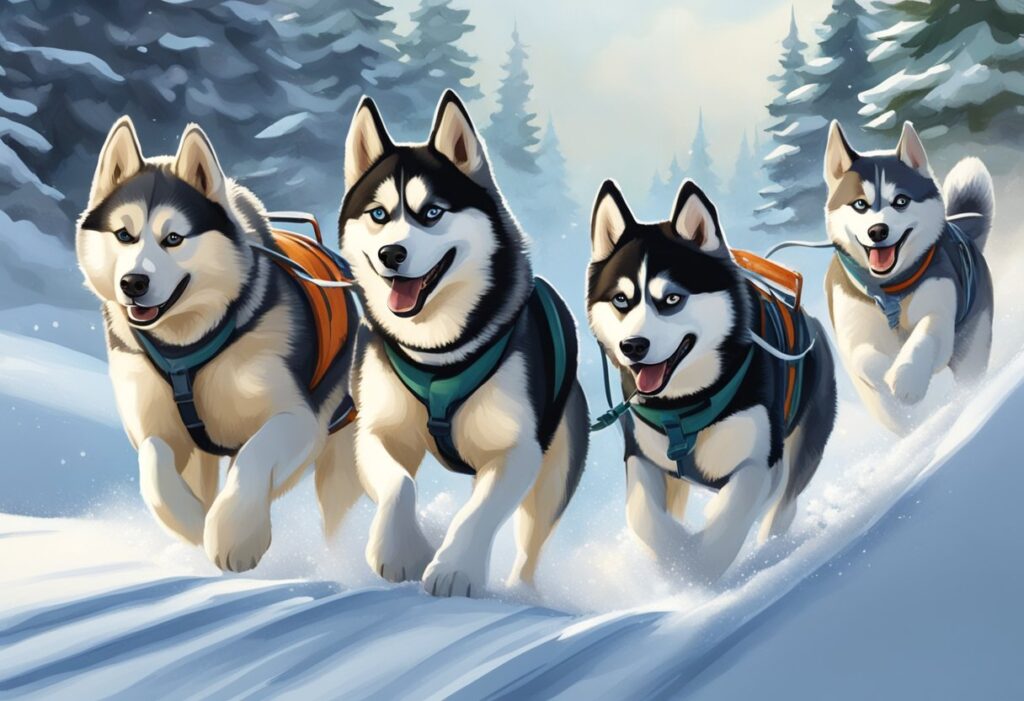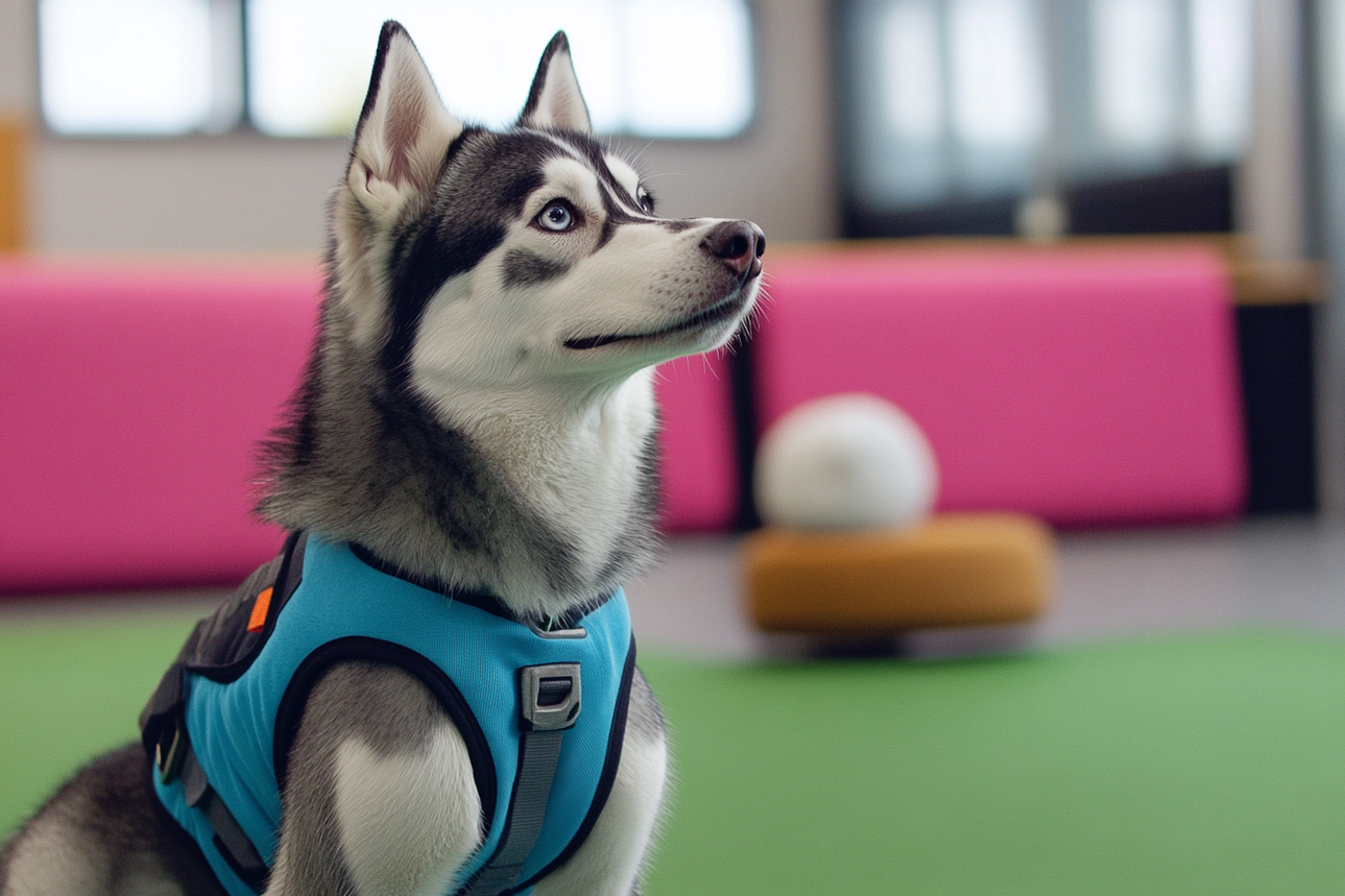Training Alaskan Huskies requires dedication and a deep understanding of their unique traits. These dogs are known for their high energy, intelligence, and strong-willed nature. Advanced training for huskies builds on basic obedience skills and focuses on challenging activities that engage their minds and bodies.

Huskies thrive on mental stimulation and physical exercise. A well-rounded training program includes activities like agility courses, scent work, and advanced obedience drills. These tasks tap into their natural instincts and help channel their energy in positive ways.
Consistent training and positive reinforcement are key to success with huskies. Regular practice sessions keep them focused and motivated. As training progresses, owners can introduce more complex commands and off-leash work to further enhance their dog’s skills and responsiveness.
Key Takeaways
- Advanced training builds on basic skills and engages huskies mentally and physically
- Consistent practice and positive reinforcement are essential for success
- Off-leash work and complex commands can enhance a husky’s skills and responsiveness
Understanding Husky Behavior
Huskies have unique traits that shape their actions and responses. Learning to read their signals and knowing their typical behaviors helps owners train and manage these spirited dogs.
Communication and Signals
Huskies use various ways to express themselves. They often howl instead of bark, a trait from their wolf ancestors. Their eyes can show different emotions – wide eyes may mean excitement, while squinting could signal discomfort. Ear positions also matter. Upright ears show alertness, while flattened ears might mean fear or submission.
Tail positions are key in husky body language. A high, wagging tail shows happiness, while a low or tucked tail may indicate stress. Huskies also use scent to communicate, often rubbing against objects or people to mark their territory.
Common Behavioral Traits
Huskies are known for their high energy and need for exercise. Without enough activity, they may become bored and destructive. They have a strong prey drive, which can lead to chasing small animals. This instinct needs careful management during walks and in open spaces.
Huskies are smart but can be stubborn. They may not always follow commands, especially if not properly motivated. These dogs are social and thrive on companionship. When left alone too long, they might develop separation anxiety, leading to excessive howling or chewing.
Digging is another common husky behavior. They often dig to make cool spots to rest or to hide toys. Providing a designated digging area can help manage this natural instinct.
Foundations of Obedience Training
Obedience training forms the basis for a well-behaved husky. It teaches essential commands and builds a strong bond between dog and owner. Proper training sets clear expectations and creates a positive relationship.
Basic Commands
Huskies need to learn five key commands: sit, stay, come, down, and heel.
Start with “sit” as it’s usually the easiest. Use treats to lure the husky into position. Say the command clearly and reward when the dog obeys. Practice in short sessions to keep the husky engaged.
“Stay” teaches impulse control. Have the husky sit, then step back. Increase distance slowly over time. “Come” is vital for safety. Use a cheerful voice and exciting rewards. “Down” can be trickier, so be patient. “Heel” keeps the husky from pulling on walks.
Always end training on a positive note. Keep sessions fun and upbeat. Huskies respond well to praise and treats.
The Role of Consistency
Consistency is key in husky training. Use the same words and hand signals each time. All family members should use identical commands. This prevents confusion and helps the husky learn faster.
Set clear rules and stick to them. Don’t allow jumping one day and scold for it the next. Be consistent with rewards too. Reward good behavior every time at first. Later, switch to random rewards to maintain the behavior.
Regular practice is crucial. Short daily sessions work better than long weekly ones. Huskies need repetition to learn. Stay calm and patient, even if progress seems slow. With time and consistency, your husky will master these foundational skills.
Positive Reinforcement Techniques
Positive reinforcement is key for training huskies. It builds trust and motivates these intelligent dogs to learn new behaviors quickly.
Rewards and Incentives
Treats work well as rewards for huskies. Small, tasty morsels like bits of cooked chicken or freeze-dried liver are good choices. Use treats sparingly to avoid overfeeding.
Praise and petting are also effective rewards. An excited “Good boy!” or scratch behind the ears can reinforce desired behaviors. Some huskies enjoy toys as rewards too.
Vary the rewards to keep training sessions fun and engaging. This prevents boredom and helps maintain the husky’s interest. Timing is crucial – give rewards immediately after the desired action.
Avoiding Negative Reinforcement
Never use physical punishment when training huskies. It can damage the bond between dog and owner and lead to fear or aggression.
Ignore unwanted behaviors instead of scolding. This teaches the husky that bad actions don’t get attention. Redirect to a positive behavior and reward that instead.
Be patient and consistent. Huskies may test boundaries, but stay calm and stick to positive methods. With time and practice, the dog will learn what’s expected.
Set realistic goals. Break complex tasks into smaller steps. This allows for more chances to reward progress and builds the husky’s confidence.
Training Challenges and Solutions
Training huskies can be tricky. They have strong personalities and get distracted easily. But with the right approach, you can succeed.
Dealing With Stubbornness
Huskies are known for their stubborn streak. They may ignore commands or do their own thing. To overcome this:
• Be consistent. Use the same commands every time.
• Offer rewards. Treats and praise work well.
• Keep sessions short. 5-10 minutes is enough.
• Make it fun. Turn training into games.
• Stay calm. Don’t get frustrated if they don’t listen.
Rotate activities to keep them engaged. Mix obedience with tricks and agility. This keeps training fresh and exciting for your husky.
Overcoming Distractions
Huskies are easily distracted by sights, sounds, and smells. This makes focus hard. Try these tips:
• Start in a quiet place with few distractions.
• Slowly add more distractions as they improve.
• Use high-value treats to keep their attention.
• Practice the “Look at me” command.
• Increase exercise before training to burn energy.
Patience is key. It may take time, but your husky can learn to focus. Celebrate small wins and keep sessions positive. With practice, they’ll get better at tuning out distractions.
Advanced Obedience and Agility
Huskies can excel at advanced training with the right approach. Complex commands and agility courses help challenge these intelligent dogs mentally and physically.
Complex Commands
Teaching huskies advanced commands builds on basic obedience skills. Start with “stay” at a distance and gradually increase the time and distractions. Teach directional commands like “left” and “right” for precise control.
Practice recall from farther distances and with distractions. Use hand signals along with verbal cues. This allows silent communication during sledding or other activities.
Teach a reliable “leave it” command for safety. This keeps huskies from picking up dangerous items. Work on a rock-solid “wait” at doors and gates to prevent escapes.
Agility Course Training
Agility training taps into a husky’s natural athleticism and problem-solving skills. Start with low jumps and tunnels. Gradually add more complex obstacles like weave poles and see-saws.
Use treats and toys as rewards, but keep sessions short and fun. Huskies can get bored easily. Mix up the course layout to keep them engaged.
Focus on precision and speed. Teach tight turns around obstacles. Practice quick stops on contact zones. Work on distance control to guide the dog from afar.
Agility improves fitness and strengthens the bond between dog and handler. It provides great mental and physical exercise for high-energy huskies.
Recall Training Strategies
Recall training is key for huskies. It keeps them safe and builds a strong bond with their owners. These methods help huskies come when called, even with distractions.
Building Reliable Recall
Start recall training in a quiet place. Use a special word or whistle as the recall cue. Say the cue and reward your husky when they come to you. Praise them and give treats.
Slowly add distractions. Practice in the yard, then in busier areas. Always reward your husky for coming back. Never punish them, even if they take a while to return.
Use a long leash for safety during outdoor training. This lets your husky explore while you keep control. Gradually increase the distance as your husky improves.
Recall Games and Exercises
Make recall fun with games. Try “hide and seek” in your home. Call your husky and reward them when they find you. This builds excitement for coming when called.
Practice “come and go” in a fenced area. Let your husky walk away, then call them back. Reward them, then release them to explore again. This teaches them that coming to you doesn’t always end playtime.
Use toys as rewards for recall. Toss a ball or start a game of tug when your husky comes to you. This makes recall more exciting than other distractions.
Set up a recall relay with family members. Take turns calling the husky and rewarding them. This teaches them to come to anyone who calls, not just one person.
Off-Leash Training Approaches
Training huskies to respond reliably off-leash requires patience and consistency. A strong foundation of obedience skills is essential before allowing a husky off-leash in open areas. Safety must remain the top priority throughout the training process.
Transitioning to Off-Leash
Start off-leash training in a secure, fenced area. Use a long training lead at first to maintain some control. Practice recall commands frequently, rewarding the husky with high-value treats for coming when called. Gradually increase distractions in the environment.
Play games that encourage the husky to stay close and check in often. Hide-and-seek can be effective – have the dog wait, then call them to find you. This builds their desire to keep track of you.
Phase out the long lead slowly. Let it drag at first, then remove it for short periods. Extend off-leash time as the husky proves reliable. Always end sessions on a positive note.
Safety and Control
Never allow a husky off-leash in unsafe areas. Huskies have high prey drives and may chase small animals. They can also roam far if given the chance. Use caution near roads or other hazards.
Teach a solid emergency recall cue. This should mean “come immediately no matter what.” Use an extra special reward that’s only given for this command. Practice it often.
Train a reliable “leave it” cue to prevent the husky from going after distractions. Start with easy items and build up to more tempting ones. Reward heavily for ignoring the distraction.
Consider using a GPS tracker on the husky’s collar as an extra safety measure during off-leash activities. This can help locate them if they do wander off.
Maintaining Training and Fitness
Keeping huskies in top shape requires ongoing effort. Regular practice of commands and physical exercise help these active dogs stay sharp and healthy.
Routine Revision of Commands
Huskies need frequent practice to keep their skills sharp. Set aside time each week to review basic commands like sit, stay, and come. Add new tricks gradually to keep training fun and challenging. Use treats and praise to reward good behavior. Practice commands in different locations to help your husky generalize their skills. Short, frequent sessions work best for these smart but sometimes stubborn dogs. Mix up the order of commands to keep your husky on their toes. If your dog struggles with a particular command, break it down into smaller steps.
Physical Conditioning
Huskies thrive on exercise. Daily walks, runs, or hikes help maintain their fitness. Start with shorter activities and build up slowly if your dog isn’t used to intense exercise. Swimming provides a low-impact workout that’s easy on joints. Pulling activities like skijoring or bikejoring tap into huskies’ natural instincts. Always check with your vet before starting a new exercise program. Watch for signs of fatigue like excessive panting or slowing down. Provide plenty of water breaks during workouts. In hot weather, exercise early in the morning or evening to avoid overheating. A tired husky is often a well-behaved husky.


Leave a Reply